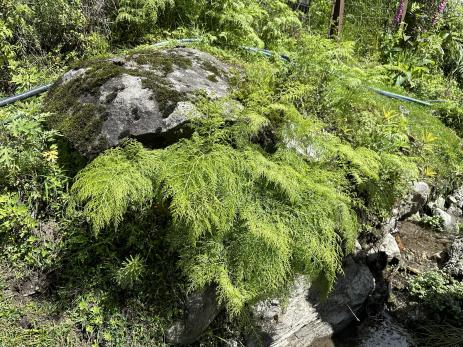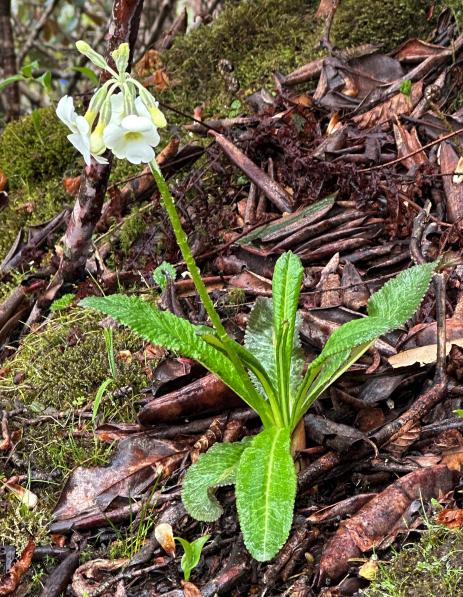Sikkim Adventure
original Published in the
2023 Fall NARGS Quarterly

By Panayoti Kelaidis
I’d never thought I’d ever go to Sikkim. I knew that to access the alpine zone in Nepal entails arduous trekking, and Bhutan bans all manner of motorized transport. I’d imagined that Sikkim would be comparable. I later found out it isn’t, but how could one organize a trip there? Then I received an email from Harry Jans in 2022 inviting me to go on a trip he was planning. I’d traveled with Harry to Tibet and realized this would be my best opportunity to visit the central Himalaya on the Indian side. I simply had to say yes. I had made some commitments (with signed contracts) that conflicted with the trip—but some fast talking and negotiations got me out of them. I could go!
Sikkim is technically “under the suzerainty of India”—a state of India in other words, although historically it was an independent monarchy. Obtaining a visa for India is not difficult, but gaining access to Sikkim is not quite so easy. The few roads that extend into Sikkim are narrow and crowded and so treacherous that tourists are obliged to employ local drivers. You must also obtain permits to access the alpine heights. All of this was done on our behalf by the tour, problems solved by signing on with Harry Jans as he’d done the dirty work.
On June 19, I found myself on a plane headed to New Dehli, where I stayed only one night, meeting my 20 fellow travelers the next morning then flying to Bagdogra airport in West Bengal where we were met by our local guide, Alister Adhikari, and drivers. Then I joined an Englishmen, two Germans, two Belgians, and two more Americans (Kelly Dodson and Sue Milliken of Far Reaches Farm), and a dozen participants from the Netherlands in launching northwards on the road from the airport. We spent that evening in Kalimpong, a bustling city perched at the border with Sikkim. The next day we explored the town and visited a very picturesque factory where paper was manufactured from the bark of edgeworthias.
The rise from the low plains of Bengal to the heights of the Himalaya takes longer than the map would suggest and I was surprised at how many villages were clustered along the way. I was especially shocked at the steepness of the mountain slopes: there were waterfalls everywhere, often tumbling hundreds of feet, and even more avalanche chutes along the way. The roads here are often blocked by enormous rockfalls that can take a week or more to repair during which time tourists and locals are often stranded. Because of the proximity of Tibet, there were large military installations at lofty elevations with frequent transport from the lowlands for provisions. The “highway” was often a single lane wide. Imagine passing a train of large army trucks. Again and again. June, July, and August are generally low traffic for tourists due to the monsoon. I cannot imagine what it must be like in winter when countless Indian tourists drive up to see snow, or in April and May when the rhododendrons are in bloom and the snowy Himalaya are clearly visible. It has to be gridlock traffic in every direction.
Our destination for most of our trip was the far north of Sikkim. We stayed in Lachung, only ten miles from Tibet, the first few days in the East, and then drove around to Lachen, further west and north, very near to Khangchendzonga National Park (named for Kangchenjunga peak, the third highest on the planet). This article will focus on the vicinity of Lachung where we stayed at the Etho Metho Hotel (We were told Etho Metho referred to the local rhododendrons, but Google Translate says एठो मीठो means “So Sweet”).
The approach to the north of Sikkim took the better part of a week, as we acclimatized to the elevation and the exotic surroundings. The south face of the Himalaya are much wetter and lusher than even the mountains of western China where I have traveled, not to speak of the much drier heights of Pakistan and Tibet. I was not prepared to see tree ferns and truly impenetrable rainforest much of the way with gesneriads, orchids, and all manner of subtropical gems growing to surprisingly high elevations. Every time we stopped we encountered different species of Impatiens and next to these a variety of Arisaema, some growing to unbelievable heights. One Arisaema tortuosum was at least six feet (1.8 m) tall! Since this was the middle of the monsoon, we wore special leggings to ward off leeches (although several members of the trip did find them attached to higher portions of their anatomies, including on the neck!)
Finally, we reach the treeline at Tsomgo Lake (12,313 feet, 3,753 m in elevation). The lake is a tourist attraction with a line of yaks decorated festively and their owners trying to lure you to get photographed alongside them. This turned out to be the mistiest day of our travel, with rain spitting occasionally and visibility restricted. There were a wealth of wildflowers blooming which shone even more brightly in the muted light.
The first flower I saw was familiar to me from Tibet: Lloydia flavonutans. It is far showier than the alplilies that grow in the Rockies. For the first time, but not the last, I was surprised to see jack-in-the-pulpits growing in full sun in the alpine zone. There are a half dozen species that grow at lofty elevations and they seem very prone to hybridizing. We saw them on every hike.
Of course, one travels halfway around the world to find Bergenia purpurascens, which looks almost identical to many of the species I already grow. But it’s always a treat to see plants one grows at home in their wild habitat.
We found several primulas, including Primula obliqua, a glowing white species we never saw again on our trip. I was familiar with many of the names and plants we saw from a lifetime of reading the great early 20th-century plant explorers.
I saw a patch of bright pink in the distance which turned out to be Diapensia himalaica, which I’d seen a few years earlier in the Tsangpo area of Tibet, the wettest part of that country that borders India. Those were quite a ways away from Sikkim. I can’t imagine how many millions of these must grow in between.
As we began walking further along the trail above the lake (the pathsides bristling with wildflowers) the rain picked up its pace. We wore Goretex and carried umbrellas but at that height the potential of lightning convinced us to return to the vehicles.
Of course, as soon as we began to drive away, the rain dissipated. Our guide Alister knew a special place just a half mile or so below the lake in fir forest that might have some different plants. Since everyone in the group was interested in woodland plants we welcomed the opportunity. The forest was remarkably diverse, with dense thickets of Rhododendron thomsonii, one of which even had a lingering flower. The flesh-pink trunks were quite large and twisted gracefully upwards, like a corps de ballet, through big patches of Polygonatum singalilense, a Solomon seal new to me. It has creamy flower buds that open into a tubby bell. There were clumps of Iris clarkei, with gorgeous purple-blue flowers. Here we first saw the Himalayan cousin of ginseng (Panax pseudoginseng) which we were to encounter on many hikes. I suspect this must not have much herbal potency, otherwise, it would surely have been over-collected like its look-alike American cousin.
Here I encountered the burnt orange flowers of Rhododendron cinnabarinum, one of the last of the genus to bloom. There were dozens of species of rhododendrons in the area. I can’t imagine what it must look like when they’re all in bloom.
The next day we encountered the only breakdown of the trip: our permits to access a special alpine pass were denied. There were military exercises taking place there and they didn’t want tourists anywhere near. I know Harry, Hanni, and Alister were bitterly disappointed, but the drives we took in their stead not far from Lachung were extraordinarily productive. It started with the towering stems of Cardiocrinum giganteum var. giganteum—the tallest and most glistening white of the genus. Although never in quantity, we saw it here and there on many hikes during the trips, something that always made our day.
The areas that had been cleared at one time for lumber were now thickets of rhododendron with masses of chrome-yellow Euphorbia sikkimensis forming lax domes wherever you looked. On one steep road bank, we found our first glowing purple Roscoea auriculata: these were just emerging—every day during the trip we were to see more of this species.
One plant that mystified me was Androsace geraniifolia. It grew in masses in every sunny spot. How can such an abundant plant not be in cultivation? It was a tad rangy, and the bright white flowers were smallish, but the scalloped leaves were attractive enough.
And then there was an amazing fern that formed masses yards across along the road cuts and in every sunny meadow. What could it possibly be? Koen Van Pouke (who owned a superb rare plant nursery in Belgium) recalled growing it and seeing it in a book—and dredged up the generic name Onychium from his memory. Kelly Dodson supplied the species name: “cryptogrammoides.” This is surely one of the most delicate, showy, and intricately divided ferns I’ve ever seen. Judging by where it grew (everywhere), it must have potential for the garden.
I saw what I took to be an orchid growing on top of a rock. This turned out to be a delicate pink cousin to Liriope called Theropogon pallidus, another plant one would yearn to grow. We found husky specimens of a blueberry (an unidentified Vaccinium) with berries almost ripe and wonderful evergreen leaves.
But the high point of the day was finding Pleione hookeriana growing in moss on the crest of a hill in the shade, at 9,022 feet (2750 m) elevation! I’d seen pleiones in China, but never at quite such heights. What a perfect way to crown the glorious first few days of a dream trip!

















